Participatory Video and Design Thinking meet in Nariño, Colombia
09 Jul 2017, Posted by in News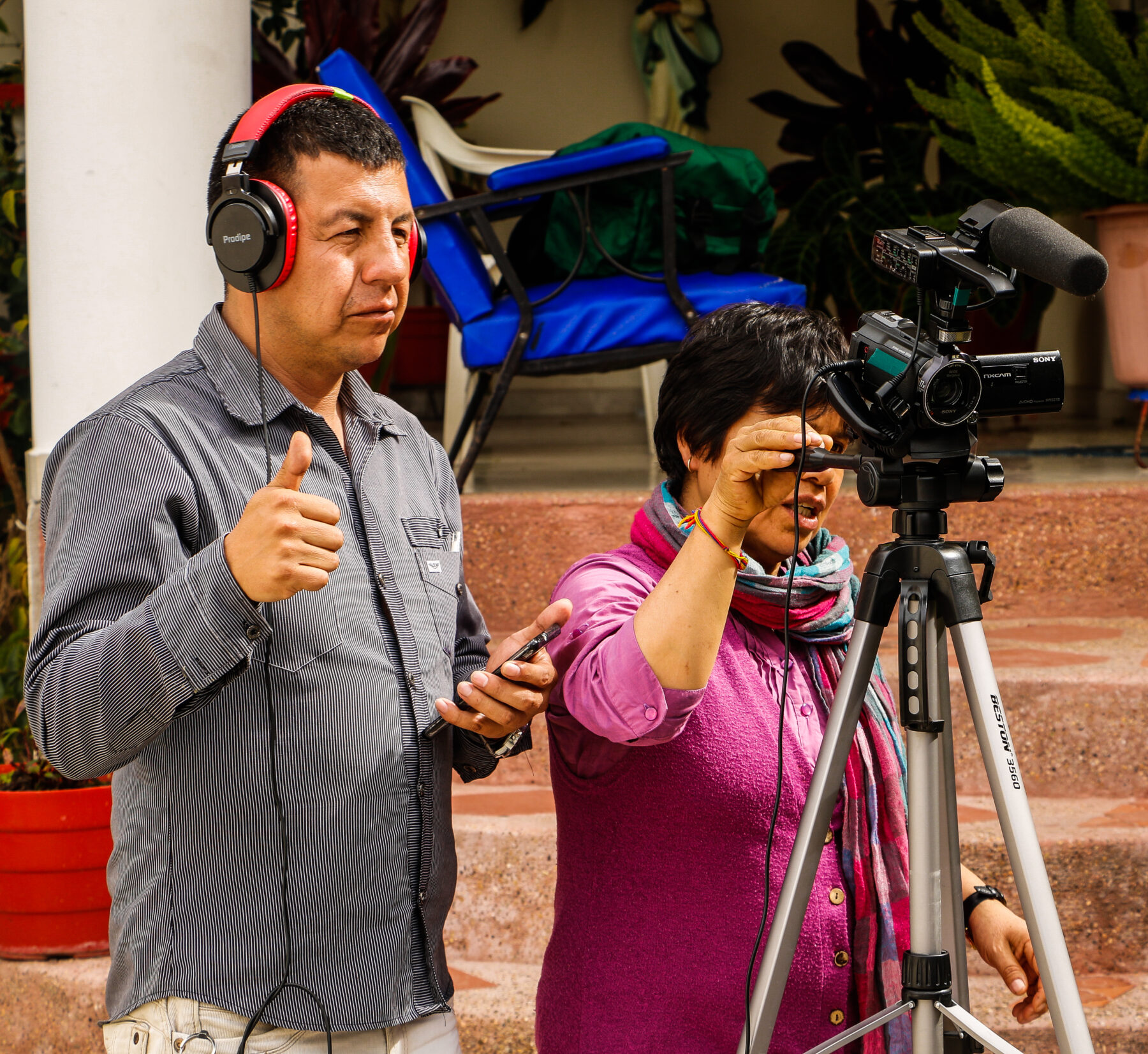
By Manon Koningstein & Chris Lunch / – Watch the project video here
Based on the article on the website of Insightshare
‘In this workshop, we were not only facilitators but also participants, and at the same time the community were not only participants, but also facilitators’ (Juan Jurado, Centre for Social Innovation in Nariño – CISNA)
In March of this year, Sivin Communications´ Manon Koningstein worked together with InsightShare (UK) and the d.school Paris (France) on a series of trainings and workshops based on a unique combination of design thinking and participatory video were carried out in Nariño province in Colombia aimed at strengthening and supporting a local “culture of social innovation”.
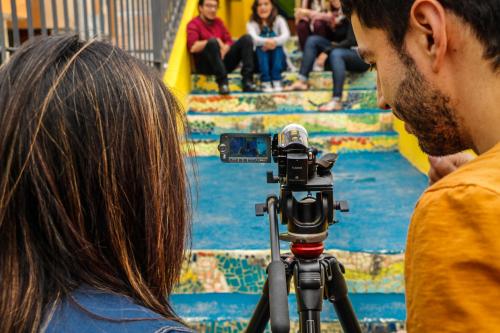
(Image: The Centre for Social Innovation in Nariño team (CISNA) learn the “disappearing game”)
‘I think this is a great methodology, especially in the field of social innovation, because it helps us to really get to our specific target groups and go even further than we have in the past’ (Camilla, CISNA)
Last year the province of Nariño hit the headlines when it elected one of Colombia’s youngest ever Governors, Camilo Romero. He has put open government, a collaborative/sharing economy and social innovation at the heart of his policy strategy and established the Centre for Social Innovation in Nariño (CISNA).
‘The idea behind CISNA is to motivate our own citizens so that they themselves can create a social innovation project, that they don´t have to wait for the authorities to take action; the action comes from within’ (Melissa Restrepo, CISNA)
Design thinking
Design thinking is a creative approach to problem solving, it begins with the people one is designing for and ends with new solutions that are tailor-made to suit their needs. It consists of three phases starting with building a deep understanding and empathy with those that will ultimately be the users of any new social project, service or product that is developed. Participatory video can help to engage the target groups from the start and hand over control, enabling them to turn the camera on themselves to identify constraints, opportunities and needs. The next phase is to generate tons of ideas, again Participatory video helps bring in diverse voices, identify locally workable solutions and reach out to groups that won’t usually come to workshops.
‘When innovating for and with people we need to develop more than just good ideas. We have to create a strong movement towards the desired impact. Design thinking enables fast testing of different exploration paths. When the tests are done with the community and the solutions become contextual and co-created the innovation is set in motion towards impact’ (Andres Felipe Bedoya Martinez, Innovation project manager, d.school Paris at école des ponts)
The Design thinking approach ensures that these participatory exercises go beyond simply generating ideas to actually developing and testing them, both in their community and with other key stakeholders. This is what is known as prototyping and is critical in breaking cycles of passive dependency or hopelessness and in creating a movement towards local action and positive change. Sometimes these prototypes are in the form of a role play or short participatory video which might convey the new experience, service or product to other community participants or ‘users’, so they can start to imagine how this might improve their lives or address some of the day to day challenges they are facing. The video element enables these solutions to be shared widely both within the local community and with wider stakeholders and decision makers. All the time the ‘users’ (who are now co-designers) are collecting feedback, refining and testing their ideas until they are ready to be implemented.
Participatory Video
‘Participatory Video is a tool that bridges worlds, unlocks doors, and involves the beneficiaries in each phase of a project. This is not [just] a video camera. This is a people magnet, pulling people together to join in, to get involved, to plan together, to unite, to take action locally and to make the changes that they want to see’ (Chris Lunch, Founder and Director, InsightShare from the TEDx talk ‘This is not a video camera’)

(Image: Each one teach one – Participatory video is controlled by the participants)
Participatory Video (PV) provides an accessible way to bring people together to explore shared issues and voice concerns. It can be a powerful platform to engage and mobilise traditionally underrepresented and underserved groups. The methodology is designed to simultaneously empower participants to engage in learning activities and voice their stories and opinions, whilst they gain confidence in their abilities to acquire new skills, improve existing knowledge and practices, and think creatively towards innovative problem-solving.
‘What makes this such an effective tool for social change is its accessibility to all participants, irrespective of literacy, background, gender or age. A powerful shift occurs when you give marginalised groups a space to share their knowledge and experiences. When we use participation as a pathway towards more respectful and insightful research we have the opportunity to conduct research with people, rather than about people’ (Manon Koningstein, InsightShare associate & Founder and Director, Sivin Communications)
Urban workshops
InsightShare and the d.school team coached CISNA staff in the use and facilitation of a Design Thinking process. Next up was a group of about 30 participants, all working on different social innovation projects in the capital of Nariño; the city of Pasto. The challenge was ‘How can CISNA support a thriving environment of social innovation in Nariño?’ Those that attended were all young leaders involved in social projects such as an urban cycling project, art projects, urban dance projects and projects addressing teenage pregnancy.
‘We come from different corners and backgrounds and through learning how to listen and dialogue with all these different people today, we are learning methods which will help us do this more effectively with other user groups too’ (Andrés Bastidas – artist name: ISMO).
Together with InsightShare and the d.school Paris, the CISNA team facilitated an actual design thinking workshop. The energy was great and the outcomes even more inspiring. The combination of brainstorming, analysing and team building exercises was very much appreciated by the participants.
‘Through the methodology I found my ideas flowing and gained a greater appreciation for the support and collaboration of my teammates. It taught me to trust the ideas of others, even when they sound crazy in the moment, and not try to solve everything by myself.’ (Carolina Lugo, urban workshop participant).
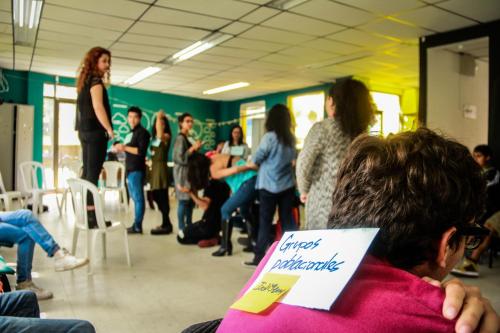
(Image: Participatory exercise exploring different stakeholder groups)
Often working well into the evenings, the participants felt that this hands-on methodology could bring them greater clarity in their work. By following this process together, new ideas were emerging. An interesting challenge was the reverse brainstorming, which aims to find the worst possible response to an emerging issue that has been identified, and then reverts these back into positive actions and responses.
‘I liked the exercise that was called ‘reverse brainstorming’, because it literally forced me out of my linear thinking process, and challenged the things that I have always been thinking and believing´ (Jose Dueñas, urban workshop participant, Nariño.)
At the end of the second day, some great products and services had been designed and were ready to be tested and implemented in real life. Examples include a step-by-step manual (called “Manuel”!) on how to identify opportunities for funding your social innovation project; a detailed structure for an online platform where users can find other local projects, regular meet-ups to discuss shared challenges and promote each other’s work and a social innovation contest where the grantees would receive an incubation period with the government in order to close the gap between the citizens doing projects and the government.
Rural workshop
The next phase of the workshop was with Indigenous leaders and teachers from various communities that were all part of the Los Pastos indigenous group in Nariño. The aim was twofold; to develop a participatory video needs assessment process which CISNA could replicate across the whole territory and to build links with the local indigenous communities and explore how CISNA could support these harder to reach groups develop their own social innovation initiatives.
The Pasto indigenous community is made up of 30 groups that are spread across the Southern parts of Colombia and the Northern parts of Ecuador. These populations are engaged in a long struggle to reclaim their ancestral lands and to prevent the loss of their indigenous culture, values and language.
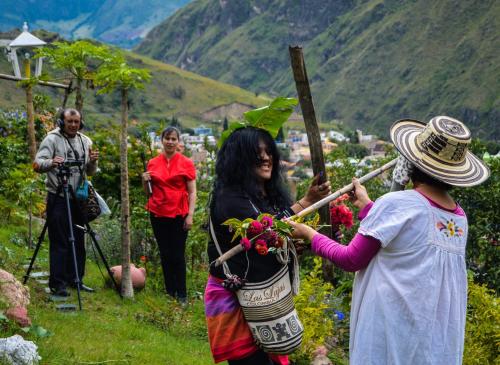
(Image: Filming a scene for their participatory video)
Three groups worked until midnight experiencing the engaging and fun participatory video games which introduce the group to the camera, enable them to try out interview techniques and focus on developing trust and understanding between the participants and the facilitators.
‘I like the use of participatory video, it gives us the chance to move our words, to move our thoughts and find a way to communicate a certain message, through the use of images. Especially for us indigenous communities, since we are oral communities, it is very important to combine our words with images’ (Lucia Moreno, Indigenous teacher & rural workshop participant).
The next day participatory activities helped the group identify specific problems in the region that affect their communities. Topics that came up included their pride in their indigenous culture and specifically their struggle to include indigenous beliefs and values in the centralised educational curriculum (so-called ethno-education). For them this was a key part of a larger focus to retain their native language, culture and customs. Topics also included the struggle these groups have been through over the years, especially in the light of the Colombian conflict. As they started to group all the issues and topics they had a sudden realisation. They noticed that whilst many of them had identified their big struggles to secure their land, education and culture, hardly any of them had mentioned the important issues that were closer to home, such as alcoholism and family breakdown. They recognised that without a strong community they would not achieve their wider goals. They decided that one group should focus their video on these ‘closer to home’ issues. A second group focussed on the issues related to land and the third group focussed on the ongoing struggle for indigenous education.

(Image: Participatory activity to identify the key issues to explore)
Their video messages are primarily aimed at key decision makers in the government, however the participants were sure that their videos would also be great tools to promote positive change within their communities. Participatory Video had helped the groups identify problems and solutions in new ways, creating safe spaces for discussion.
Using participatory video helped CISNA show a very human face, one that was ready to listen and make a meaningful connection with the indigenous population who, after so many years of struggle, are understandably very wary of working with outsiders and with the government. Having witnessed the participatory video workshop and after speaking with the participants, Ernesto Ramiro Estacio, a Pastos indigenous leader and currently environment secretary for the government of Narino, declared; “you have earned our trust and now you are part of our community, we are ready to work together”. He has seen the potential of this work to create change and real impact in his community and has pledged to provide additional financial support to that promised by CISNA for ongoing work with this group.
WATCH IN FULL SCREEN & TURN ON ENGLISH SUBTITLES (bottom right) to get a real taste of the project.
References & Suggested Reading
Azadegan, Shadi (2016) “We are not alone”: Nicaragua’s rural youth tell their story. Read it online here
Beckman, S. L., & Barry, M. (2007). Innovation as a Learning Process: Embedding Design
Brown, Tim (2008). Design Thinking. Harvard Business Review, june 2008.
Brown, T. & Wyatt, J. (2010). Design Thinking for Social Innovation. Stanford Social Innovation Review Stanford, CA: USA
Hillen, V. (2014). Place. In Hillen, V. 101 Landmarks I’ve discovered to innovate thanks to design thinking. Retrieved from www.veroniquehillen.com
Lunch, Chris & Nick (2006) “Insights into participatory video”, Oxford. Download the handbook for free here
Lunch, N (2016) “Indigenous Peoples behind the Camera”: Read it online here
Roth, B. (2015) The Achievement Habit. Harper Collins
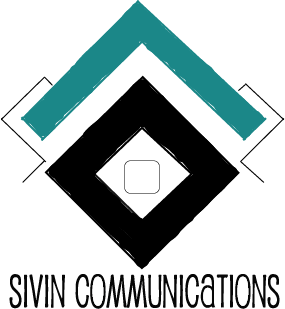
[…] Participatory Video and Design Thinking in the Colombian Nariño, you can read all about that here and watch the final […]